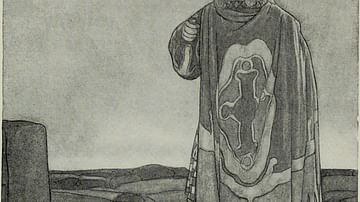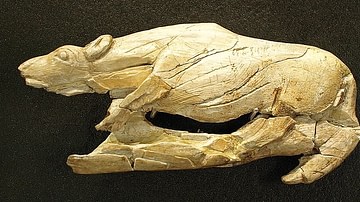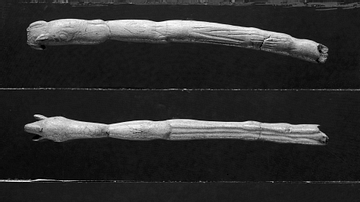Uʻtlûñ′tă, the Spear-Finger is a legend of the Cherokee nation, defined as a wonder story – a tale involving a supernatural entity – in which higher powers contend with each other or mortals must navigate the supernatural world or defend themselves against demons or monsters. In Uʻtlûñ′tă, The Spear-Finger, that monster is a liver-eating ogress.
Uʻtlûñ′tă is similar to the Basket Ogress of the Northwest Coast nations, such as the Salish, who is depicted as a giant woman who preys on children – especially those who are careless, fail to heed their parents, or regularly behave badly in any other way – snatching them up and carrying them away in her great basket to later eat in her cave. A significant difference between the two is that Uʻtlûñ′tă is a shape-shifter who can appear as anyone and so easily catches children – and adults – unaware of the danger, killing them by eating their liver.

She is also similar to another supernatural entity of the Cherokee, the Raven Mocker, a withered creature who flies through the air, creating the sound of rushing winds, to prey on the sick, weak, and those close to death. The Raven Mocker extends its own life by stealing the person's heart and appears as a withered, elderly person – male or female – because, although they continually extend their lives, their bodies age. Uʻtlûñ′tă differs from the Raven Mocker in several ways, but, as with the Basket Ogress, primarily in her ability to shape-shift and her habit of killing people, of all ages, for no reason at all.
Owing to her ability to appear as absolutely anyone – whether a stranger or someone from a person's village or outlying community – Uʻtlûñ′tă is understood as one of the most dangerous entities in Native American, specifically Cherokee, lore. Her shape-shifting abilities also associate her with the Native American concept of the witch, most notably the Skin-Walker of the Navajo nation.
The Shape-Shifter
The most famous shape-shifter in Native American lore is the Skin-Walker, a shape-shifting entity who was once a shaman ("medicine man" or "medicine woman") but embraced the darker forces of the spirit world. Since they have magical powers and are able to inflict severe injury, disease, or death, they are regarded as witches – understood as men or women who harness such powers for evil purposes – and because they had mastered powerful medicine (spiritual power) in service to the Great Spirit and the bright forces of harmony and balance, they are especially dangerous once they turn from service to others and live only for their own self-gratification.
In turning from light to darkness, the Skin-Walker becomes a threat to the balance of the natural world – which, in Native American lore, includes the unseen, the "supernatural", realms – and so her actions are not only a danger to a given community or village but to the whole of creation. In Cherokee belief, there is the higher realm of bright spirits and the Creator, Unetlanvhi, the mortal plane of Earth, and the lower world of dark spirits who bring disorder, disease, and death. The purpose of a human's life was to help maintain the balance of these three planes of existence. Scholar Larry J. Zimmerman writes:
For Native North Americans, the boundaries between the world of the spirits and the world of living people were not clearly defined: a third, "in-between" world of transition separated them. Every entity to some degree inhabited all three of these worlds. If a human carried out appropriate rituals, he or she could be transformed into a being from one of the other two worlds.
(126)
In the case of the Skin-Walker, the former shaman might assume the form of a benevolent bright spirit, an animal, a person, or anything else. There is nothing in Uʻtlûñ′tă, The Spear-Finger to suggest she was once a medicine woman but, rather, has always been aligned with the forces of disorder and death. She is among the many supernatural entities found throughout Native American legend and lore – like the Bakwas, Wendigo, or Flying Head – who embody the dangers of the world and threats to one's personal and communal safety.
Text
The following is taken from Myths of the Cherokee (1900) by James Mooney, republished by Dover Publications in 2014.
The story would have served several purposes for an original audience, aside from entertainment. The threat of the Spear-Finger suddenly appearing to kill children (when she appeared in her natural form) would have made them cautious at the approach of a strange woman, serving the same basic purpose as the "stranger danger" phrase used with children today. For adults, the story might explain why someone seemed to die for no reason – with no wounds or marks on the body – when they had seemed to be in perfect health.
Uʻtlûñ′tă, The Spear-Finger is also an origin myth explaining how the titmouse and chickadee came to be regarded as they are as well as how rocks came to be distributed along the river of the region of Tennessee where the story takes place. The legend explores many of the themes common to Native American literature including the importance of teamwork and placing the good of the community above one's self-interest. The story remains as popular in Cherokee society today as it was in the past and is among the best-known.
Long, long ago—hĭlahi′yu—there dwelt in the mountains a terrible ogress, a woman monster, whose food was human livers. She could take on any shape or appearance to suit her purpose, but in her right form she looked very much like an old woman, excepting that her whole body was covered with a skin as hard as a rock that no weapon could wound or penetrate, and that on her right hand she had a long, stony forefinger of bone, like an awl or spearhead, with which she stabbed everyone to whom she could get near enough. On account of this fact, she was called Uʻtlûñ′tă, "Spear-finger," and on account of her stony skin she was sometimes called Nûñ′yunu′wĭ, "Stone-dress." There was another stone-clothed monster that killed people, but that is a different story.
Spear-finger had such powers over stone that she could easily lift and carry immense rocks and could cement them together by merely striking one against another. To get over the rough country more easily she undertook to build a great rock bridge through the air from Nûñyû′-tluʻgûñ′yĭ, the "Tree rock," on Hiwassee, over to Sanigilâ′gĭ (Whiteside mountain), on the Blue ridge, and had it well started from the top of the "Tree rock" when the lightning struck it and scattered the fragments along the whole ridge, where the pieces can still be seen by those who go there. She used to range all over the mountains about the heads of the streams and in the dark passes of Nantahala, always hungry and looking for victims. Her favorite haunt on the Tennessee side was about the gap on the trail where Chilhowee mountain comes down to the river.
Sometimes an old woman would approach along the trail where the children were picking strawberries or playing near the village, and would say to them coaxingly, "Come, my grandchildren, come to your granny and let granny dress your hair." When some little girl ran up and laid her head in the old woman's lap to be petted and combed the old witch would gently run her fingers through the child's hair until it went to sleep, when she would stab the little one through the heart or back of the neck with the long awl finger, which she had kept hidden under her robe. Then she would take out the liver and eat it.
She would enter a house by taking the appearance of one of the family who happened to have gone out for a short time and would watch her chance to stab someone with her long finger and take out his liver. She could stab him without being noticed, and often the victim did not even know it himself at the time—for it left no wound and caused no pain—but went on about his own affairs, until all at once he felt weak and began gradually to pine away, and was always sure to die, because Spear-finger had taken his liver.
When the Cherokee went out in the fall, according to their custom, to burn the leaves off from the mountains in order to get the chestnuts on the ground, they were never safe, for the old witch was always on the lookout, and as soon as she saw the smoke rise, she knew there were Indians there and sneaked up to try to surprise one alone. So, as well as they could they tried to keep together, and were very cautious of allowing any stranger to approach the camp. But if one went down to the spring for a drink, they never knew but it might be the liver eater that came back and sat with them.
Sometimes she took her proper form, and once or twice, when far out from the settlements, a solitary hunter had seen an old woman, with a queer-looking hand, going through the woods singing low to herself:
Uwe′la nátsĭkû′. Su′ să′ sai′.
Liver, I eat it. Su′ să′ sai′.
It was rather a pretty song, but it chilled his blood, for he knew it was the liver eater, and he hurried away, silently, before she might see him.
At last, a great council was held to devise some means to get rid of Uʼtlûñ′tă before she should destroy everybody. The people came from all around, and after much talk it was decided that the best way would be to trap her in a pitfall where all the warriors could attack her at once. So, they dug a deep pitfall across the trail and covered it over with earth and grass as if the ground had never been disturbed. Then they kindled a large fire of brush near the trail and hid themselves in the laurels, because they knew she would come as soon as she saw the smoke.
Sure enough, they soon saw an old woman coming along the trail. She looked like an old woman whom they knew well in the village, and although several of the wiser men wanted to shoot at her, the others interfered, because they did not want to hurt one of their own people. The old woman came slowly along the trail, with one hand under her blanket, until she stepped upon the pitfall and tumbled through the brush top into the deep hole below. Then, at once, she showed her true nature, and instead of the feeble old woman there was the terrible Uʼtlûñ′tă with her stony skin, and her sharp awl finger reaching out in every direction for someone to stab.
The hunters rushed out from the thicket and surrounded the pit but, shoot as true and as often as they could, their arrows struck the stony mail of the witch only to be broken and fall useless at her feet, while she taunted them and tried to climb out of the pit to get at them. They kept out of her way but were only wasting their arrows when a small bird, Utsŭ′ʻgĭ, the titmouse, perched on a tree overhead and began to sing "un, un, un." They thought it was saying u′nahŭ′, heart, meaning that they should aim at the heart of the stone witch. They directed their arrows where the heart should be, but the arrows only glanced off with the flint heads broken.
Then they caught the Utsŭ′ʻgĭ and cut off its tongue, so that ever since its tongue is short and everybody knows it is a liar. When the hunters let it go, it flew straight up into the sky until it was out of sight and never came back again. The titmouse that we know now is only an image of the other.
They kept up the fight without result until another bird, little Tsĭ′kĭlilĭ′, the chickadee, flew down from a tree and alighted upon the witch's right hand. The warriors took this as a sign that they must aim there, and they were right, for her heart was on the inside of her hand, which she kept doubled into a fist, this same awl hand with which she had stabbed so many people. Now she was frightened in earnest and began to rush furiously at them with her long awl finger and to jump about in the pit to dodge the arrows, until at last a lucky arrow struck just where the awl joined her wrist and she fell down dead.
Ever since the tsĭ′kĭlilĭ′ is known as a truth teller, and when a man is away on a journey, if this bird comes and perches near the house and chirps its song, his friends know he will soon be safe home.






